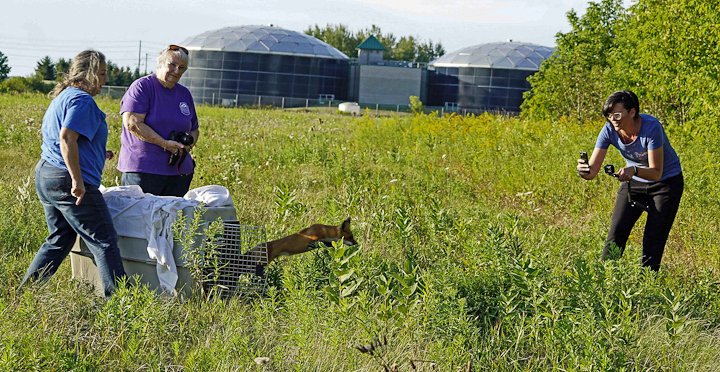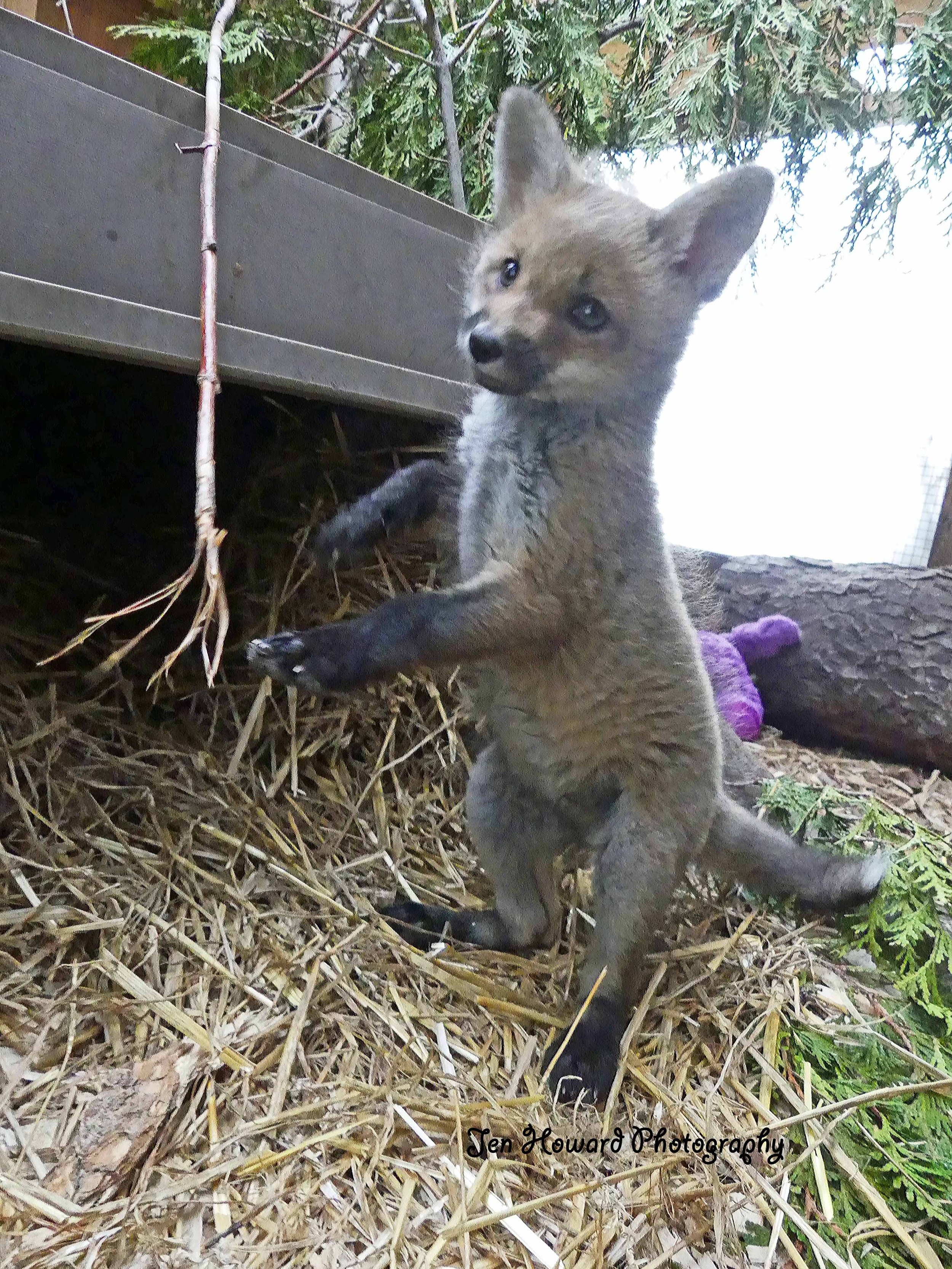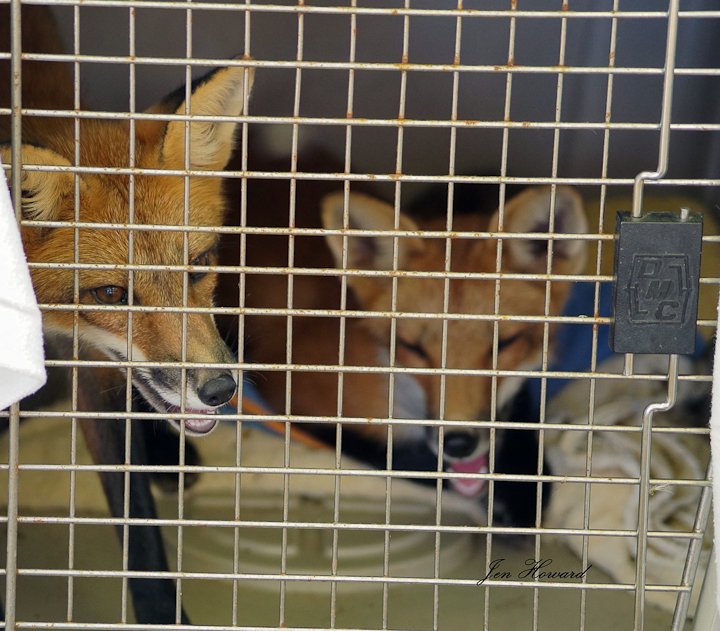Wildlife rescue: Living with foxes and other garden wildlife
If you are fortunate enough to have foxes living in or near your garden consider yourself lucky. These entertaining little critters are great to have in your yard to control mice and rats.
Are foxes good or bad to have around the garden
All Photographs by Jennifer Howard
Count yourself lucky if you are fortunate enough to have a fox living in or visiting your garden on a daily basis.
Besides keeping rodents like mice and rats at bay, having a fox family living or visiting your woodland garden is likely a signal that your garden is healthy and offers good habitat for an upper level predator. That includes access to an abundant supply of food, water and shelter.
“If you are lucky enough to have a family of foxes move into your yard. Please try to let them stay. It’s a wonderful experience watching them raise their kits from a distance,” explains Jennifer Howard, a wildlife rescue and rehabilitator at Procyon Wildlife Centre in Beeton Ontario.
“They are incredible parents and to be honest, until the wee ones start to come out of the den at around 3 to 4 weeks you may not even know they are there,” she adds.
A beautiful photograph of a fox rambling through the garden.
Can foxes be removed from your yard humanely?
If having a family of foxes in your yard is unworkable, you may be able to gently convince the family to move on to another denning site.
“Foxes do have more than one den. If they are disturbed too much by their human neighbours the foxes will move their kits to another den,” explains Howard.
Playing music near the den and staying close by making some noise whenever possible might be enough to convince the parents to move the kits to a second den. You should never use loud noises to stress out the animals.
“But personally, if it were me,” says Howard. “I would be thrilled (with the fox family) and would work around it. And allow them their space. They have a hard enough time as it is living in our world of craziness, what is a few months of sharing. After all, it was their space first and we are taking it away at an alarming rate. It’s very sad,” she adds.
There is no need to feed foxes in the backyard. Foxes are perfectly capable of finding thier own prey. When they do, they pounce on their prey to stun it before eating it.
Should I feed foxes in my backyard?
Feeding foxes, unlike birds, is not a good idea. These upper level predators need to retain their wildness and eat a healthy, raw diet rather than become habituated to eating processed food provided by humans.
“They are wild,” says Howard. “both parents feed the kits and teach them how to hunt. They need to stay wild and eat the proper diet. The kits learn from their parents and you are not helping if you feed them. In fact, you may do them more harm.”
The only time Howard recommends feeding foxes is if the animals are being live trapped for medical reasons.
“They don’t need your help. They are born into this world to hunt live prey or eat road kill,” she explains.
But the biggest reason not to feed the foxes in your yard is the risk of the fox “losing their healthy fear of humans.”
“Not all humans are kind,” she says. “Because the foxes are not afraid to approach people for handouts, they may be shot or injured in some other way.”
Foxes that have been fed by a human can begin to approach other humans who think there is something wrong with the animals usually attributing the friendliness to rabies.
A fox makes itself at home in the garden, sitting in a wooden barrel.
Will feeding foxes attract other animals
“By feeding our furry critters you have no control over who you will attract – Opossums, raccoons, skunks, weasels, rabbits, and even bears,” says Howard.
Feeding foxes also creates the potential of increasing rodents in the backyard.
“Since rodents are the main food source for foxes, if you feed the foxes they may have no need to eat the rodents you have attracted. An abundance of rodents in the garden is never a good thing especially if they find a way into your home or shed.
Howard adds that feeding foxes could also attract a sick animal with distemper or mange to your yard, which, in turn, could infect otherwise healthy animals or even pets.
“Distemper is a horrible disease to which there is no cure,” she adds. “It affects the animal’s brain and it is the worst thing for wildlife rehabilitators because euthanasia is the only thing we can do,” adds Howard.
“Raccoons and skunks have been awful,” at the Procyon Wildlife Centre, explains Howard. “Raccoons carry raccoon roundworm which can be contagious to your pets and you. But raccoons show no sign of having the disease and it doesn’t harm them. Distemper can be passed to foxes as well. Do you still want to feed them? Keep them wild, let them hunt and forage for food the way Mother Nature intended them to do, and what they know to do. These are incredibly beautiful animals that have been forced to coexist among us. And they do that very well.
Will foxes attack our cat or dog?
Foxes have virtually no interest in attacking your cat and even less in attacking a dog. A fox’s life depends on staying healthy and any injury, even a small one that could result from say a cat’s claws, could end in death for the fox. These animals are too intelligent to pick a prey that is a potential threat to them. A mouse, grasshoppers and maybe a squirrel or rat are better choices.
It needs to be noted, however, that a kitten, puppy or very small dog might be prey for an adult fox, especially if it is feeding kits. These animals should never be left out alone in the backyard anyway.
“Let them continue to coexist on their own, they won’t eat your cats or dogs or attack you. You now must learn to coexist with them. It’s a beautiful relationship when it’s done right,” Howard adds.
More information from Ferns & Feathers on Foxes
Wildlife Rescue: The Year of the Fox
Wildlife Rescue: The year of the Fox
Mange in foxes can be deadly if left untreated but it is relative easy to cure if the application of proper medication is given in a timely fashion. Follow Procyon Wildlife volunteer staff as they tackle an onslaught of wild foxes inflicted with mange. Their rescue and recovery and eventual release.
All photos courtesy of Jennifer Howard
Is mange in foxes fatal or easily cured?
The year 2021 will be memorable for the wildlife workers at Procyon Wildlife Rehabilitation and Education Centre for one reason: Foxes and plenty of them.
The wildlife centre in Beeton Ontario north of Toronto was inundated with red foxes in need of help.
Most of the foxes that were rescued by centre staff suffered from mange, but a few were admitted for head trauma resulting from collisions with vehicles. All of the foxes were saved and most have been released. Depending on the severity of the mange, and how early it was caught, curing the animal can be relatively easy with proper administration of medication. However, if left untreated foxes will die from mange.
“In years past we would maybe get two, up to maybe five foxes in the wildlife centre,” explains Jennifer Howard, a volunteer rescuer and rehabilitator at the centre.
“At the moment we have four foxes in our care and, I believe, this is the most we have had in at one time,” Howard explained at the time this article was put together in late fall. “Usually it works out that one is ready to go when a new one comes in. It was almost like an assembly line of foxes coming and going. it was pretty crazy!”
“However in 2021 it was an extremely bad year for mange, Howard explains. In Innisfil (a small village in rural Ontario) alone I got 19 foxes all with mange in various stages. Plus we got a couple car collisions from other areas and other cases of mange from other areas. All total I believe about 28 red foxes were admitted last year.”
Some of those foxes celebrated New Years at the facility and were still getting treatment into january 2022.
And the situation does not appear to be letting up. Already, the wildlife centre has admitted its first fox of the year on January 6 with mange.
For more on the work wildlife rescue and rehabilitators perform, be sure to take a look at my entertaining and informative article about Angels For Wildlife.
This fox shows advanced mange illustrated by bare patches and crusty, scabs on the skin.
For those who may not know about Sarcoptic Mange, sometimes called canine scabies, it is a type of skin disease, caused by parasitic mites. The mites that cause mange in mammals embed themselves by burrowing into the animals’ skin or hair follicles.
If left untreated, mange will cause the animal intense itching from an allergic reaction to the mites’ feces. Severe crusting develops on the animal’s skin that often becomes infected. The combination of infection, crusting (often around the eyes) and hair loss can progress until the fox is unable to care for itself or hunt, and it loses the insulation from its fur resulting in a slow and painful death.
If you see or have foxes in your garden, check out this article on the Fox Den in your garden and helping fox with mange.
The good news is that, if the animal is rescued in time, treatment is simple enough that they can be returned to the wild in most cases in a few short weeks. Secondary problems that may or may not be related to the illness can be more difficult to treat and result in a longer stay at the wildlife center.
Ever heard a fox scream. It’s terrifying but fascinating. For more on why foxes scream, check out my post here.
(More on the identification and treatment of mange in foxes is spelled out in this earlier article in Ferns & Feathers about recognizing mange in foxes living in, or using your woodland/wildlife garden.)
The good news is that all the foxes at Procyon Wildlife Centre are doing well and are either already set free or are on the road back to freedom.
“Some of those foxes had other issues, sores on their rump, minor injuries on a leg or foot, or were severely emaciated. But mange was the dominating issue,” Howard explains.
Many of the foxes admitted last year were kits, but thankfully, they were old enough so no special treatment was needed in their care.
But, a few years back, there was a special, very young little fox that was found alone in the snow with its eyes still closed.
“She was found in the snow with some fur from the den around her. No one knew how she got there,” explains Howard.
The tiny fox “was hypothermic, hungry, dehydrated and in critical condition” when they rescued her.
One of Procyon’s board of directors and animal caregivers took her home for round-the-clock care. Residents in the area even “donated fur coats to us so we could swaddle the tiny fox in fur (just like she would have received from her mother).” A soft stuffed toy was added for her to cuddle.
“She was adorable. She came back and forth on the days her caregiver came in only after she was stable. She became more curious day by day and was handled by only her caregiver at that time,” explains Howard.
Her story, as told by her caregiver Sarah Marrs Bruce, is one staff won’t soon forget.
Talitha, a tiny rescued kit, needed round-the-clock care until it got old enough to begin eating on its own.
Meet Talitha: Procyon’s youngest and tiniest fox kit ever
When Talitha arrived, she had been called in as a baby raccoon.
This, most likely, was because her fur was still in the grey phase and not showing any of the typical red fox colouring yet. The colouring can take a few weeks to grow in, in the meantime serving as a part of the kit’s protection against predators – helping them blend into their dens.
She was still eyes-closed and estimated to be approximately 7-10 days old.
Staff used stuffed animals to keep Talitha comforted when she was alone.
She had been found in a snowbank surrounded by torn up fur that could have been from litter mates or her mother. It took a couple days to get her stabilized – warmed up and hydrated and able to handle diluted specialized formula.
She needed comfort but we needed to be very careful about not habituating her to humans. Once her eyes were open we provided her cuddle buddies that were stuffies (including one that had its own heartbeat). At the same time we blocked visual access to her caregiver (in an attempt to keep her as wild as possible.)
She progressed quite quickly from nursing on a “magic nipple” to eating a soft-porridge-like food made from a combination of species specific infant formula mixed with liquified kibble.
The images below show Talitha growing up with her buddy and her eventual release.




As soon as she could feed herself without assistance and was gaining weight reliably on her own, she was quickly moved into a larger outside enclosure to even further reduce her exposure to people. At that time we began searching throughout the province for another fox near her age that she could socialize with. Foxes are very social animals and it was essential to her development to be around other foxes to learn vocalizations and normal social behaviour with conspecifics.
“Caring for her was one of the highlights of my experiences as a volunteer and one that I won't ever forget. Her release together with another fox from the area was a joyful day for myself and several others.”
Work at the Centre never really ends
“After the baby stages, we are very careful to limit the handling of the animals to very few people, explains Howard, “Especially fawns, raccoons, foxes and coyotes, who are easily habituated to humans.”
Staff where gowns and masks and try not to speak in the presence of the animals. They only go out to feed and change the animal’s water at this point.
Rehabilitation Centres from other parts of the province work together to create the best environment for the animals to grow up knowing how to act and survive out in the wild.
“These species also need others of their kind, to bond with, play with, and learn from each other. That is of utmost importance so they do not get attached to their caregiver. We will search for others their age until we find one from other rehabilitation centres, then they either come to us or we go to them.”
In conclusion
The dedication and commitment shown by the volunteer staff at Procyon Wildlife Rehabilitation and Educational Centre is a testament to the type of people who have a special place in their hearts for our wild critters. This same dedication is to helping wildlife occurs everyday in rescue and wildlife refuges in the United States, Canada, the Europe, and throughout the world in countries big and small. Animals of all kinds, from the largest elephants to the tiniest creatures. As habitats are destroyed, either from natural calamities such as wildfires to the slow encroachment of urbanization, it is important for gardeners to do our part to recreate habitat in our yards for many of these creatures.
It is also falling to us to keep an eye on our backyard friends to ensure they are safe and free from illness. That includes everything from keeping our bird feeders and bird baths clean to stop the spread of disease, to taking immediate action if we see a sick or injured animal such as foxes suffering from mange in our woodland/wildlife gardens.
Take the time to look up your local wildlife refuge and make a donation. If you can donate your time or skills, I’m sure they would welcome it with open arms, if you cannot, a financial contribution to any one of these non-profit groups will go a long way to help them help our wild friends.
Ever wonder why foxes scream out in the night. Check out my story here.
The following are helpful Resources for homeowners looking for wildlife rescue and rehabilitation assistance
Worldwide
In Canada
https://www.nwrfcanada.org/what-we-do
http://www.ontariowildliferescue.ca/contact.php
https://www.ontario.ca/page/find-wildlife-rehabilitator
In the United States
• Here is an extensive state-by-state listing from the Humane Society of the United States on how to find a wildlife rehabilitator
https://www.humanesociety.org/resources/how-find-wildlife-rehabilitator
In the United Kingdom
https://www.rspca.org.uk/adviceandwelfare/wildlife/findarehabilitator
• The British Wildlife Rehabilitation Council includes a clickable download of UK rehabilitators
http://www.bwrc.org.uk/FindaRehabilitator
• Here is an extensive list of UK Animal Rescuers from Animal Rescuers.co.uk











